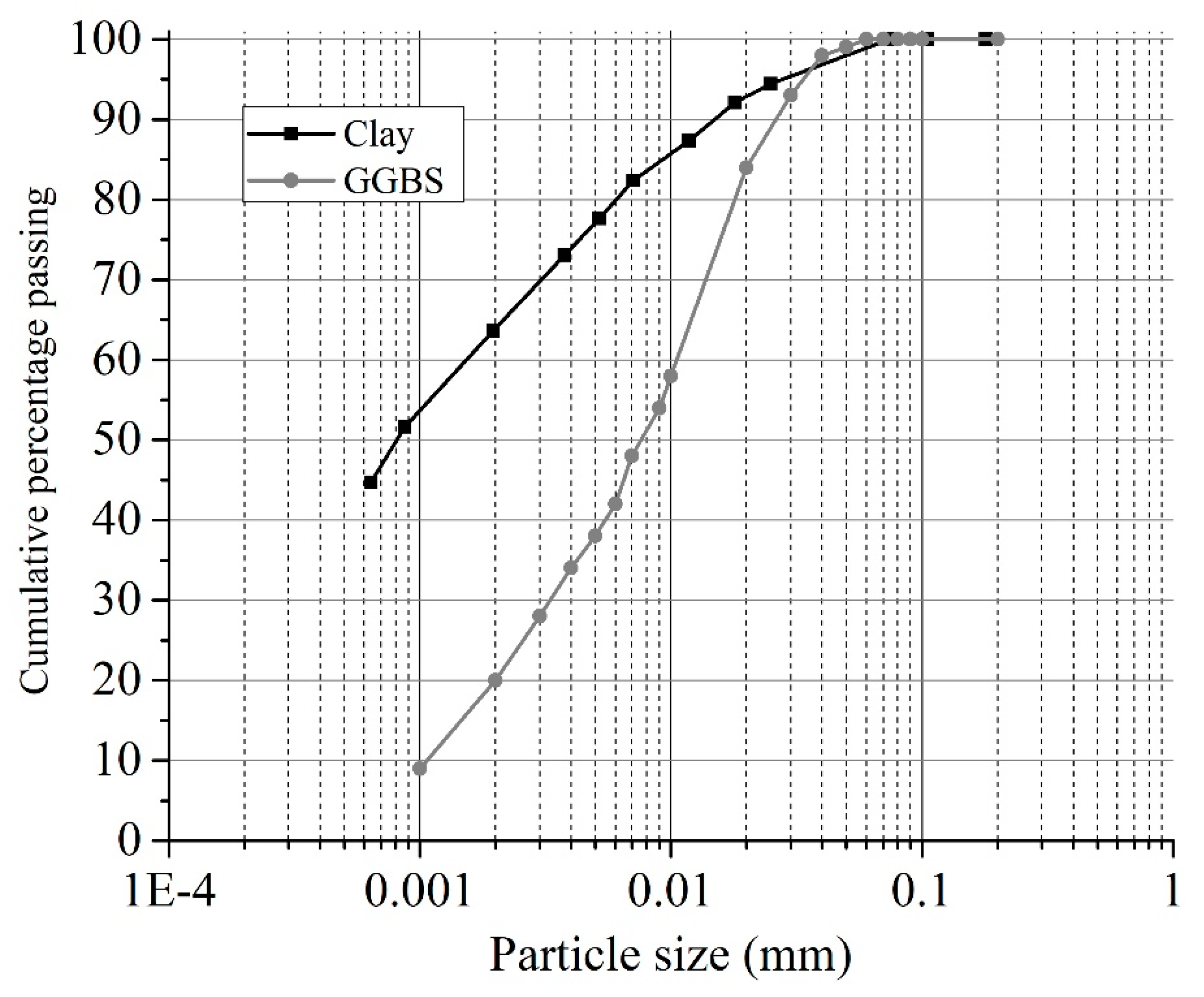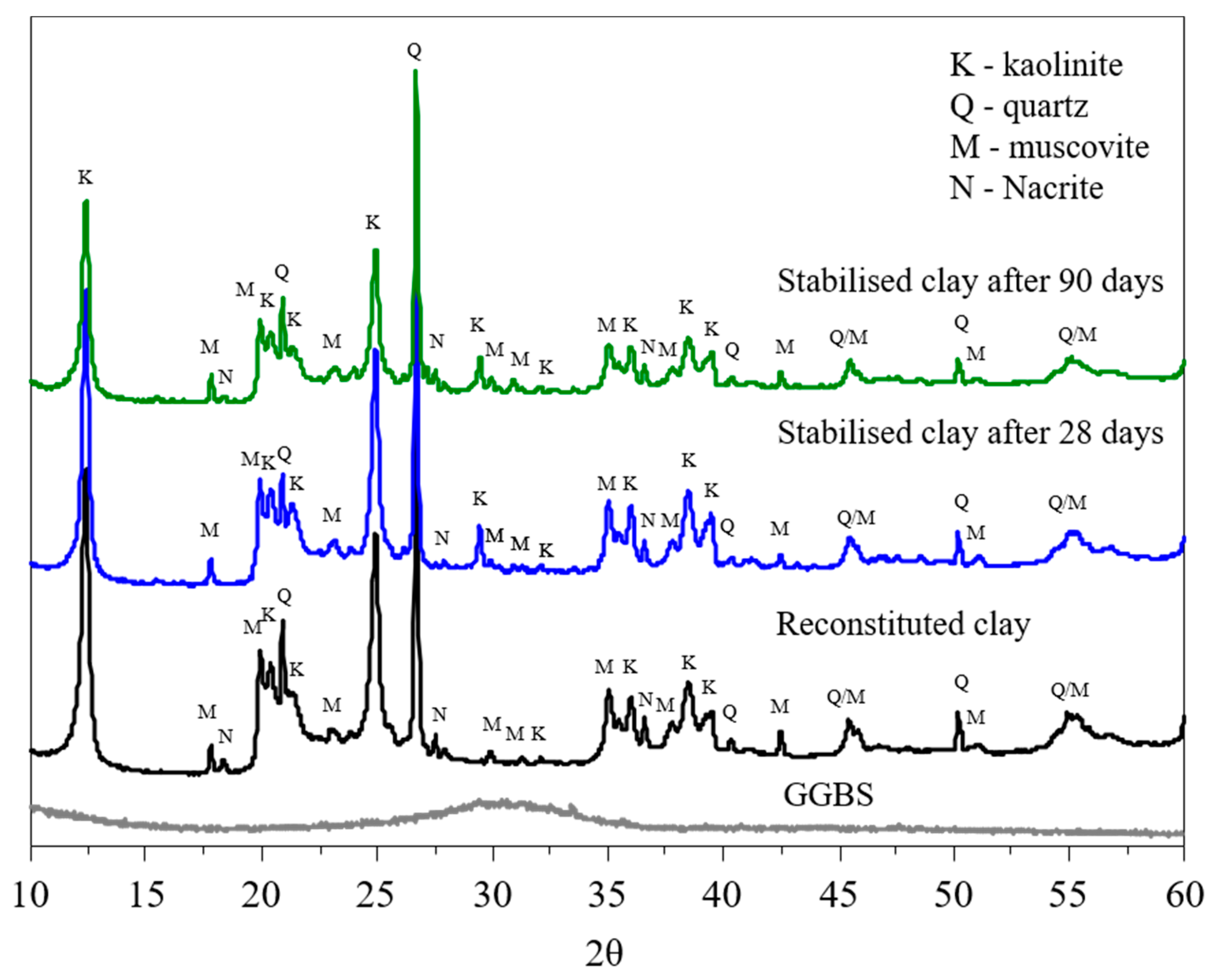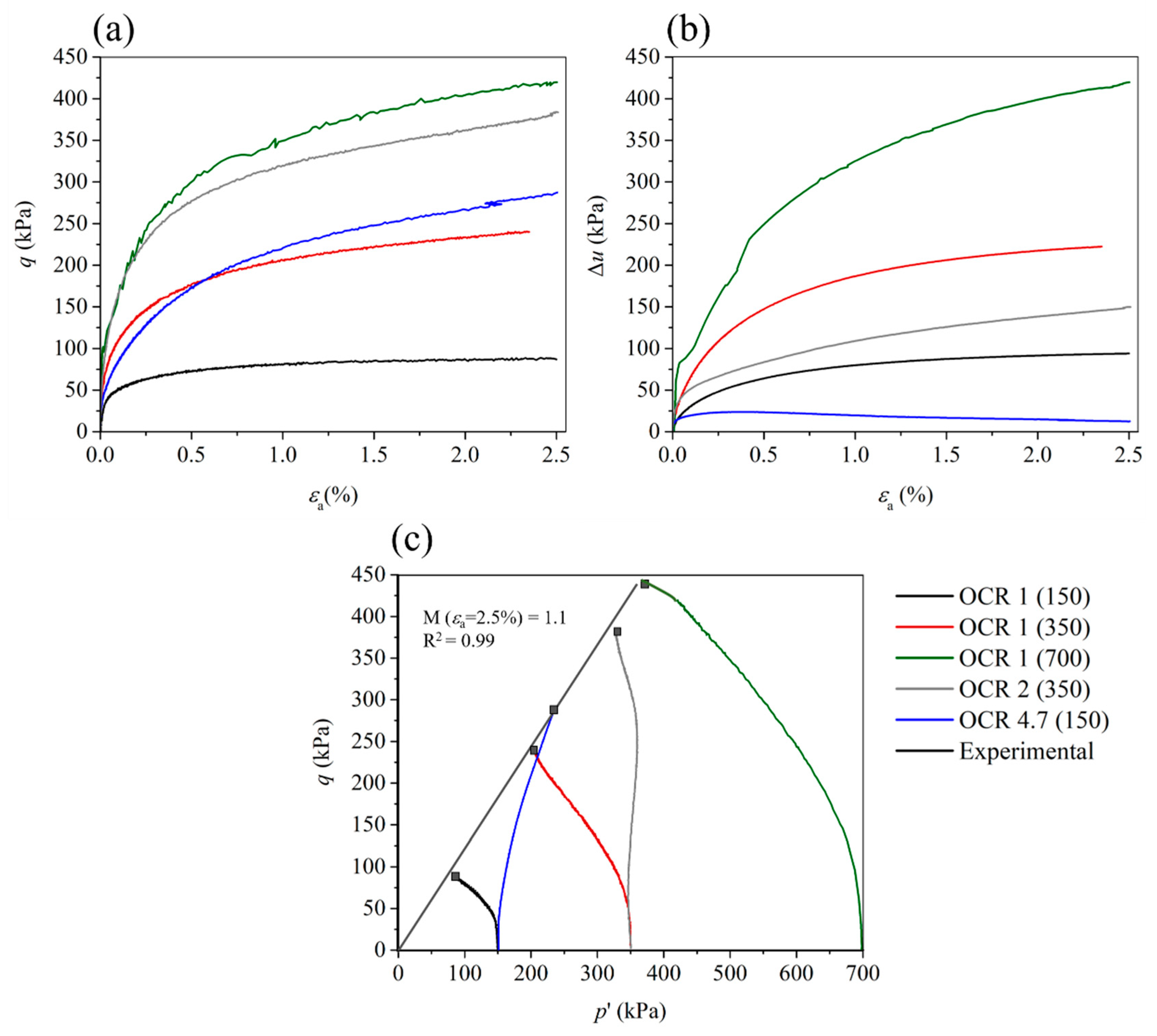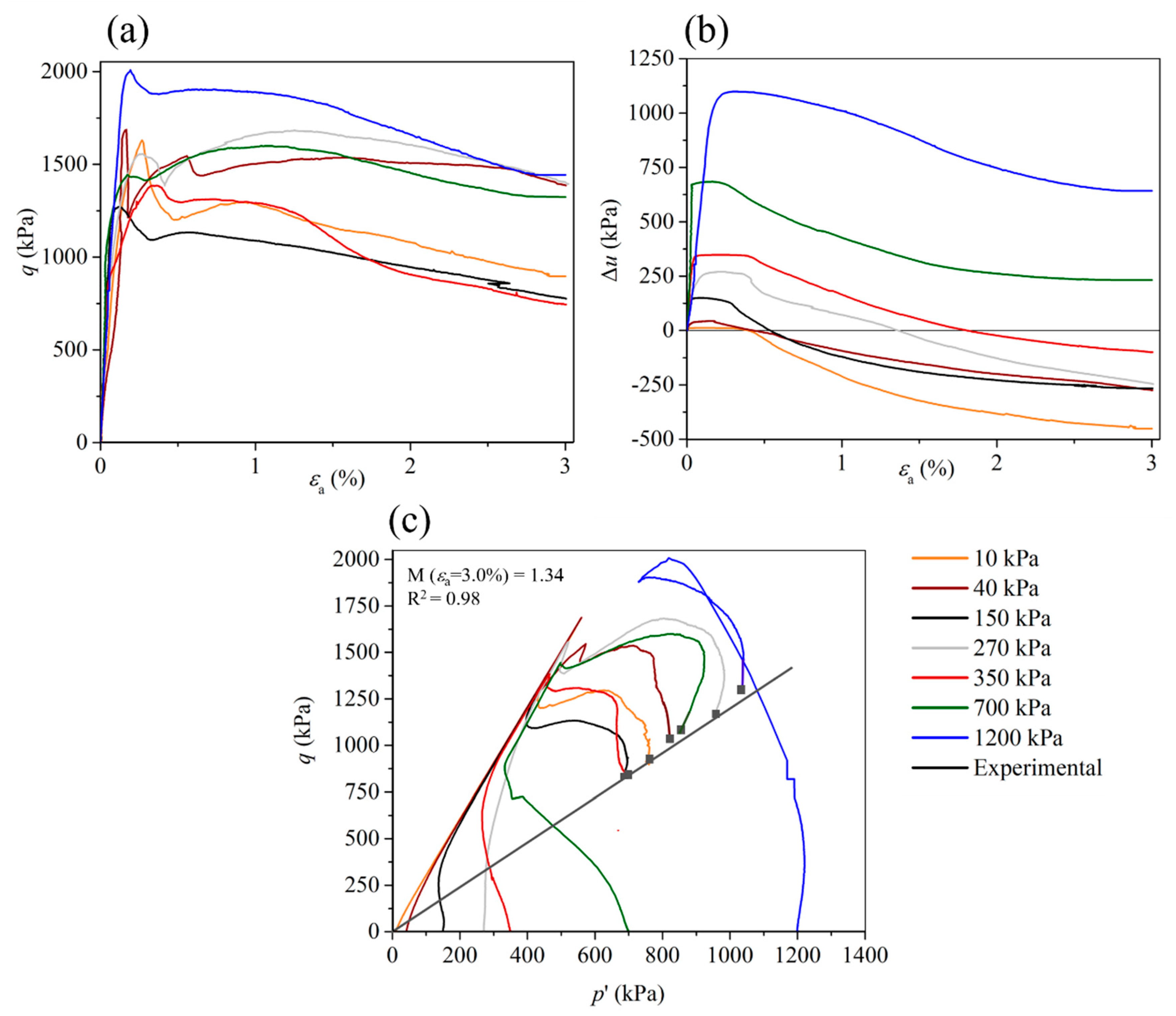1. Introduction
Soft, clay-rich soils are frequently used in geotechnical engineering practice. These soils, known to be potentially problematic due to their undesirable geotechnical properties, such as high water content, low strength, and susceptibility to large settlements, are significantly challenging. Many stabilisation methods based on the addition of cementing agents (e.g., ordinary Portland cement (OPC), lime, slag, fly ash, etc.), such as deep mixing, shallow soil mixing, and jet grouting, are now routinely applied to increase the bearing capacity, reduce deformability, and control the swelling of these soils. Although many cementing binders have been developed, OPC is still the most extensively used binder due to its availability and effectiveness.
Cement production is one of the main factors affecting environmental pollution, with considerable amounts of CO
2 and air pollutants, including SO
2, NO
X, CO, and particulate matter (PM), released into the atmosphere [
1]. Approximately 90% of CO
2 emissions of industrial origin are related to the cement industry [
2], accounting for approximately 8% of global CO
2 emissions [
3]. To address this issue, efforts have been made to develop low-carbon-footprint binders with similar performance to that OPC in recent years.
Alkali-activated binders have attracted considerable research attention due to their potential. These binders are synthesised from amorphous Si-Al-based waste in an alkaline environment. When OPC, blast furnace slag, or cement kiln dust are used as calcium-based precursors to blend with aluminosilicate precursors, the hydration products consist of a mixture of C-S-H (calcium silicate hydrate) and C-(N)-A-S-H (calcium-sodium aluminosilicate hydrate)-type gels [
4,
5]. Calcined clays (e.g., metakaolin), fly ash, or mine waste with high silica and alumina and low calcium contents lead to the formation of a three-dimensional, essentially amorphous aluminosilicate gel [
6]. Development has progressed to the level of ultra-high-performance concretes suitable for structural applications [
7,
8] and, with adequate behaviour in terms of durability [
9] and sustainability.
Researchers have extensively reported the effectiveness of adding alkali-activated binders with distinct precursors for soil stabilisation, including fly ash [
10,
11,
12], blast furnace slag [
13,
14], a blend of fly ash and blast furnace slag [
15,
16], and metakaolin [
17,
18]. Alternative activators have been proposed; for example, calcium carbide residue was used to activate coal gangue [
19]. Another recent innovation is the use of calcined lateritic soils as a precursor, with very effective results [
20]. Even expansive soils were successfully stabilised with a fly ash-based alkaline cement [
21], which proved very effective, especially in comparison with Portland cement. The focus of such studies has not been solely on mechanical performance, as the potential for durability enhancement has also been targeted. Results reported by Luo et al. [
22] show that after 90 days of immersion in a 2.5% sodium sulphate solution, geopolymer-stabilised soil showed higher strength and lower erosion than Portland-cement-based control specimens.
Regarding the shear behaviour of stabilised materials, studies are still scarce, which was a main motivation for the present study. Nevertheless, authors have reported general increases in stiffness and of the peak and residual shear strength after stabilisation, regardless of the curing period. Furthermore, Abdullah et al. [
23] reported that confining stress has a considerable influence on the stress–strain behaviour and pore pressure development of clay stabilised with a fly ash/granulated slag geopolymer. Corrêa-Silva et al. [
24] and Rios et al. [
25] observed a stress–strain behaviour typical of cement-treated soils when studying the behaviour of sandy clay and silty sand stabilised with alkali-activated blast furnace slags and fly ash, respectively. The same authors [
24] also reported that confinement stress has a significant impact on the shear strength of treated soils, with an increase in both peak and residual deviatoric stresses with increased initial mean effective stress. Increased normalised shear strength/stiffness and a tendency for dilation were also observed during the shear phase with increasing overconsolidation ratio (OCR). Sargent et al. [
26] reported higher values of maximum dilatation for an alluvial soil stabilised with alkali-activated blast furnace slag than those observed in reconstituted and undisturbed soil under the same confining stress. The authors associated this trend with the onset of softening behaviour caused by the breakdown of the cementitious bonding structure.
Understanding the shear behaviour of stabilised clays is of considerable importance for strength and deformation analysis in engineering practice. Numerous constitutive models for cement-treated clays have been developed by extending the constitutive models representing the ‘natural bond’ for natural clays to the ‘artificial cementation bond’ structured for stabilised clays [
27,
28]. However, these models refer to Portland-cement-based stabilisation. For the calibration of such models, triaxial response data are essential, and the data published on this subject are limited when alkali-activated binders are used to stabilise soft soils.
The aim of the present study is to investigate the mechanical behaviour (based on triaxial tests) of a reconstituted and stabilised clay with high initial water content using alkali-activated blast furnace slag after curing for 28 days. Monotonic consolidated undrained (CU) triaxial tests based on a wide range of initial mean effective stress (
p’
0) and isotropic compression tests were undertaken for both materials, using hall-effect transducers for a more accurate measurement of the deformations of the specimens. Scanning electron microscopy (SEM), energy dispersive spectroscopy (EDS), and X-ray diffraction (XRD) tests were carried out to characterise the microstructure of the soil–binder matrices, whereas environmental performance was assessed through analysis of the leachate collected after 28- and 90-day curing periods. The triaxial test data were then used to explore the capacity of a kinematic hardening constitutive model, as proposed by Rouainia and Muir Wood [
29], to predict the experimentally observed stress–strain behaviour for both reconstituted and stabilised clay specimens. This model was previously implemented in a finite element code and has been extensively applied to a wide range of geotechnical problems under monotonic and cyclic behaviour on natural, remoulded, and overconsolidated clays [
30]. However, all these studies were developed using Portland cement as the stabilizing agent.
5. Model Calibration and Predicted Stress–Strain Curves
The kinematic hardening model has 12 input parameters (see
Table 1). The fitted set of parameters for the reconstituted and stabilised clay cured for 28 days is shown in
Table 10 and
Table 11, respectively. The majority of the parameters was manually fitted by means of a trial-and-error procedure (best fitting between the experimental curves with the calibrated curves). The triaxial test results were crucial during this task, as they helped with the estimation of these parameters. Details about the calibration process are presented below.
The first step in the calibration process was the establishment of the initial conditions of the tests, that is, the size of the surfaces (pc0), centre of the bubble yield surface (), and the centre of the structure surface () or r0 and η0, in addition to the drainage conditions (drained or undrained).
Within the elastic domain, the response of the model is isotropic, and the elastic properties are expressed by the bulk and shear moduli (K and G) which depend on the pressure (p’). Two parameters are required to describe the elastic behaviour, namely κ* and ν. The ν was fixed at to 0.45 for both the reconstituted and stabilised clays, which is a value close to 0.5 because the triaxial tests were conducted under undrained conditions.
The elastic parameter (
κ*) and the plastic/elastic–plastic parameter (
λ*) determined in log
p’-(1 +
e) scale (
Table 7) were first converted to the ln
p’-ln (1 +
e) scale using Equation (1). Both
κ* and
λ*, which control the stiffness in the elastic region and the peak position on the stress–strain curves, respectively, were introduced into the model and then manually calibrated for each material and
p’
0 applied in the tests. Lower values of
κ* were fitted for the stabilised clay cured for 28 days compared to its reconstituted state, which is in line with the isotropic compression results presented in
Figure 5.
The parameter
M, which controls the geometry of the surfaces, was determined based on the triaxial test results presented
Figure 6 and
Figure 7 according to the shearing resistance in effective stresses of the reconstituted (
ϕ’= 26° at
εa = 2.5%) and stabilised (
ϕ’= 34°
εa = 3%) clay. Although the tests were stopped shortly after failure, the trend of the results suggests that no drop in strength would have occurred under continued strain. Moreover, the initial rapid pore-pressure build-up observed in both materials, which was reduced to a negligible rate when the tests were stopped, together with M adjusted (i.e., R
2 value) to close to 1, validate the presented results (see
Figure 6b,c and
Figure 7b,c). The
M parameter was characterised by a straight line with a slope of 1.1 (R
2 ≈ 0.99) and 1.34 (R
2 ≈ 0.98) for the reconstituted and stabilised clay, respectively.
For the reconstituted clay, the parameter
pc0 was also defined based on the triaxial tests, considering the correspondent OCR, according to Equation (2).
where:
is the maximum pressure applied during the consolidation phase; and
is the final pressure applied during the consolidation phase, which was equal to p’0 at the beginning of the shear phase.
The applied
p’
max was 700 kPa for OCR 4.7 (150) and OCR 2 (350) specimens, in agreement with the values of the parameter
pc0 introduced in the model (
Table 10).
For the stabilised clay, the parameter
pc0 was not directly determined based on the triaxial tests. The development of artificial cementation within the clay matrix led to the enlargement of the structure surface, which implies that both the size of the surfaces (represented by
pc0) and parameter
r0, which describes the relative sizes of the structure and references surfaces, increased to unknown values. The values of these two parameters were then manually fitted using a trial-and-error procedure (best fitting between the experimental and calibrated curves). The parameter
pc0 was varied from 84 kPa–362 kPa (reconstituted clay) to 475 kPa–610 kPa (stabilised clay), whereas the parameter
r0 was varied from 1.2 (reconstituted clay) to 2–5 (stabilised clay) (
Table 10 and
Table 11). The parameter
r0 was fixed close to 1 for the clay, as it is a reconstituted soil, meaning that the structure and reference surfaces have the same shapes. The increase in
r0 led to a higher and sharper peak in the stress–strain relationship predicted by the model. On the reconstituted clay specimens, the increase in
p’
0 led to an increase in
pc0. However, no trend was observed on the stabilised clay. These parameter values are in line with the observed experimental behaviour, whereby the peak and post-peak strengths increased with increased
p’
0 for the clay (
Figure 6a), unlike the stabilised clay specimens (
Figure 7a).
According to the SEM images presented in
Figure 4, both reconstituted and stabilised clays were idealized as isotropic materials, i.e.,
η0 = 0.
Destructuration is controlled by two parameters,
A and
k. Parameter
A controls the relative contribution of distortional and volumetric plastic strains during destructuration, in the range of 0 <
A < 1. For the reconstituted clay,
A was fixed to 1, so the destructuration process was entirely caused by the distortional component of the damaged strain, which predominantly occurs under undrained conditions (
Table 10). For the stabilised clay, the best fit between the experimental and the calibrated curves was achieved for
A values close to 0 (
Table 11). The parameter
k expresses the rate of damage to the structure with plastic strain, and it was manually calibrated for both materials for the
p’
0 applied during the shear phase. A reduction in
k increases the peak strength and stiffness because the rate of destructuration is reduced.
The remaining three parameters introduced by the bubble surface, i.e., the ratio of sizes of the bubble and the reference surface (R), the stiffness interpolation parameter (B), and the stiffness interpolation exponent (Ψ), were fitted using a trial-and-error procedure until a good match between the experimental and calibrated curves was achieved. The increase in B led to a higher peak in the stress–strain plot and an increase in the plastic-hardening modulus. An increased value of Ψ led to softer behaviour from small to large strain levels or, in other words, to lower values of the overall deviatoric strength response. Lower values of R led to a stiffer response in the low-strain region, with increased values of peak and residual strengths.
Figure 9a–c and
Figure 10a,b present the experimental stress–strain curves and the predicted curves using the kinematic hardening model. Solid lines represent the experimental behaviour determined through triaxial tests, whereas the dotted lines represent the model predictions using the fitted set of parameters presented in
Table 10 and
Table 11.
The good fit between the experimental stress–strain curves and the predicted curves using the kinematic hardening model revealed the potential of the model for application in different materials than for which it was initially formulated. The model accurately predicted the trend of the strain-hardening behaviour observed for the reconstituted clay before peak strength (
Figure 9a). The experimental strain-softening behaviour for almost all stabilised clay specimens was also well-predicted by the model for the wide range of applied
p’
0 values (
Figure 10a). The peak and post-peak shear strengths predicted by the model also generally coincide with those observed in the tests. The smooth response suggests that plastic deformations and hardening occurred as the bubble began to move inside the structure surface. The dependence of the shear modulus on the mean effective stress, together with the variation in plastic stiffness as the bubble approached the structure surface, allow to model more accurately predict the non-linearity of these curves. All the predicted effective stress paths for the reconstituted clay (
Figure 9b) are similar to the experimental data and converge toward the critical state line.

















